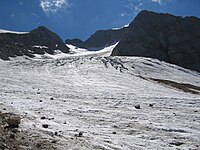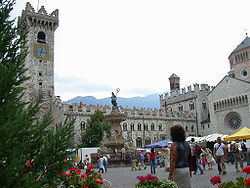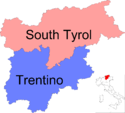| Revision as of 03:16, 7 February 2009 editRibotBOT (talk | contribs)69,737 editsm robot Modifying: tr:Trentino-Alto Adige← Previous edit | Revision as of 09:28, 7 February 2009 edit undoSupparluca (talk | contribs)5,455 edits partial revert: no need to use double names, they're used neither in English nor by the inhabitants - readded English name "Trentino"Next edit → | ||
| Line 1: | Line 1: | ||
| {{Infobox_ProvinceIT| | {{Infobox_ProvinceIT| | ||
| fullname = Provincia autonoma di Trento |
fullname = Provincia autonoma di Trento| | ||
| name = Trento| | name = Trento| | ||
| region = ]| | region = ]| | ||
| Line 18: | Line 18: | ||
| }} | }} | ||
| The '''Province of Trento''' ({{lang-it|Provincia autonoma di Trento}}, |
The '''Province of Trento''' ({{lang-it|Provincia autonoma di Trento}}), also called '''Trentino''', is an ] ] of ].<ref>{{cite web | ||
| | title = Autonomy Statute | | title = Autonomy Statute | ||
| | work = |
| work = Official website of the Province | ||
| | url = http://www.giunta.provincia.tn.it/binary/pat_giunta/statuti/nuovo_statuto_speciale.1123837117.doc | | url = http://www.giunta.provincia.tn.it/binary/pat_giunta/statuti/nuovo_statuto_speciale.1123837117.doc | ||
| | accessdate = 2007-07-06 |format=DOC}}</ref> In the local languages, typically the word ''Trentin'' is used. |
| accessdate = 2007-07-06 |format=DOC}}</ref> In the local languages, typically the word ''Trentin'' is used. | ||
| | title = Welschtirol | |||
| | work = AEIOU | |||
| | url = http://aeiou.iicm.tugraz.at/aeiou.encyclop.w/w425872.htm;internal&action=_setlanguage.action?LANGUAGE=en | |||
| | accessdate = 2009-02-06 |format=}}</ref>). | |||
| The Province of Trento is one of the two provinces which make up ] of ], which itself is an autonomous region. The province is divided into 223 ''comuni'' (municipalities).<ref>{{cite web | The Province of Trento is one of the two provinces which make up ] of ], which itself is an autonomous region. The province is divided into 223 ''comuni'' (municipalities).<ref>{{cite web | ||
| Line 34: | Line 30: | ||
| | accessdate = 2007-07-06 }}</ref>. Its capital is the city of ]. The province has an area of 6,207 km² and a total population of 507,030 (2006). The region is renowned for its ], such as the ], which compose a significant section of the ]. | | accessdate = 2007-07-06 }}</ref>. Its capital is the city of ]. The province has an area of 6,207 km² and a total population of 507,030 (2006). The region is renowned for its ], such as the ], which compose a significant section of the ]. | ||
| ==Geography |
==Geography== | ||
| ] |
] glacier]] | ||
| The Province of Trento is an almost entirely mountainous province with a main valley crossing it in its center. This valley is called ''Valle dell'Adige'' (Adige Valley), named after the ] flowing within it. The principal towns of Trentino lay on the Adige Valley as it is the largest one and has been a historical passage connecting Italy with Northern Europe. Among other important valleys are ], known for its apple production, ], ], which has been historically contended by Trento and ], Val di Fiemme and many others. | The Province of Trento is an almost entirely mountainous province with a main valley crossing it in its center. This valley is called ''Valle dell'Adige'' (Adige Valley), named after the ] flowing within it. The principal towns of Trentino lay on the Adige Valley as it is the largest one and has been a historical passage connecting Italy with Northern Europe. Among other important valleys are ], known for its apple production, ], ], which has been historically contended by Trento and ], Val di Fiemme and many others. | ||
| The province has an area of 6,214 km², and a total population of 507,030 (2006). There are 223 '']'' (singular: '']''), in the province. | The province has an area of 6,214 km², and a total population of 507,030 (2006). There are 223 '']'' (singular: '']''), in the province. | ||
| == |
==Politics== | ||
| Administratively, the province enjoys a large autonomy in the following sectors: health, school, welfare, infrastructures. The provincial council is formed by 35 members, one of which belonging by statute to the Ladin minority. The president of the provincial council alternates with the President of the ] as president of the Trentino-Alto Adige/Südtirol region. In the last ], the strongest party became the Democratic Party (''Partito Democratico del Trentino'') with 8 deputies, ] (7), ] (6), ] (5), ] (3), ] (2), Greens and Democrats of Trentino (1), ] (1), ] (1) and ] (1). |
Administratively, the province enjoys a large autonomy in the following sectors: health, school, welfare, infrastructures. The provincial council is formed by 35 members, one of which belonging by statute to the Ladin minority. The president of the provincial council alternates with the President of the ] as president of the Trentino-Alto Adige/Südtirol region. In the last ], the strongest party became the Democratic Party (''Partito Democratico del Trentino'') with 8 deputies, ] (7), ] (6), ] (5), ] (3), ] (2), Greens and Democrats of Trentino (1), ] (1), ] (1) and ] (1). | ||
| == |
==Administration== | ||
| Due the high fractionization of the territory, comprising 223 ''comuni'', often of small or even tiny size, in the late 1970s a subdivision called '']'' ("communities") was introduced. The council of each ''comprensorio'' is elected by the ''comuni'' forming it. However, this subdivision has raised criticism, and a reform is underway, aiming to the creation of 16 more omogenous "Valley Communities". | Due the high fractionization of the territory, comprising 223 ''comuni'', often of small or even tiny size, in the late 1970s a subdivision called '']'' ("communities") was introduced. The council of each ''comprensorio'' is elected by the ''comuni'' forming it. However, this subdivision has raised criticism, and a reform is underway, aiming to the creation of 16 more omogenous "Valley Communities". | ||
| ] | ] | ||
| Line 77: | Line 72: | ||
| As of ] ], the only ''comuni'' with a population over 20,000 were ] and ]. | As of ] ], the only ''comuni'' with a population over 20,000 were ] and ]. | ||
| == |
==Economy== | ||
| Despite the prevalent mountainous nature of the territory, the agricultural sector is relevant. The farms are often united in a wide net of cooperatives. The main productions include: ]s (50% of national production, together with South Tyrol) and other fruit, vegetables (mainly in the ]) and ]: important especially for its quality, the latter is used for the production of renowned wines and sparkling wines. | Despite the prevalent mountainous nature of the territory, the agricultural sector is relevant. The farms are often united in a wide net of cooperatives. The main productions include: ]s (50% of national production, together with South Tyrol) and other fruit, vegetables (mainly in the ]) and ]: important especially for its quality, the latter is used for the production of renowned wines and sparkling wines. | ||
| ] | ] | ||
| Line 86: | Line 81: | ||
| Tourism is the mainstay of the provincial economy. The main resorts include: ], ], ], ], ], ], ], ], ] and ], ] and ], these last three being renowned thermal stations. | Tourism is the mainstay of the provincial economy. The main resorts include: ], ], ], ], ], ], ], ], ] and ], ] and ], these last three being renowned thermal stations. | ||
| == |
==Transportation== | ||
| The Trentino is crossed by the main transportation connections between Italy and ]. These include the Brennero A22 highway and roadline, passing through the Adige Valley. A regional project of switching much of the road traffic to railways is current under study, including the construction of a tunnel under the ]. | The Trentino is crossed by the main transportation connections between Italy and ]. These include the Brennero A22 highway and roadline, passing through the Adige Valley. A regional project of switching much of the road traffic to railways is current under study, including the construction of a tunnel under the ]. | ||
| The province has two more railways: the Valsugana Railroad, connecting Trento to ] and the Trento-Malè-Marilleva. | The province has two more railways: the Valsugana Railroad, connecting Trento to ] and the Trento-Malè-Marilleva. | ||
| == |
==Linguistic minorities== | ||
| The province of Trento is home to three linguistic minorities, protected by the regional and provincial statutes. The most numerous is the ] minority in the ] (''comuni'' of ], ], ], Moena, ], Soraga, ]). | The province of Trento is home to three linguistic minorities, protected by the regional and provincial statutes. The most numerous is the ] minority in the ] (''comuni'' of ], ], ], Moena, ], Soraga, ]). | ||
| The German ] is spoken in the ''comuni'' of ], ] and ], while the ] is spoken in ]. | The German ] is spoken in the ''comuni'' of ], ] and ], while the ] is spoken in ]. | ||
| == |
==History== | ||
| {{main|History of Trentino}} | {{main|History of Trentino}} | ||
| The History of Trentino begins in the mid-] the valleys of what is now Trentino were already inhabited by man, the main settlements being in the valley of the ] River, thanks for its milder climate. | The History of Trentino begins in the mid-] the valleys of what is now Trentino were already inhabited by man, the main settlements being in the valley of the ] River, thanks for its milder climate. | ||
| == |
==Research in agriculture== | ||
| {{main|Research in agriculture}} | {{main|Research in agriculture}} | ||
| The Province of Trento, since January 2008, has established the ] to enhance the research, training and services in the agricultural, agri-food and environmental field. | The Province of Trento, since January 2008, has established the ] to enhance the research, training and services in the agricultural, agri-food and environmental field. | ||
| == |
==References== | ||
| {{Reflist}} | {{Reflist}} | ||
| == |
==See also== | ||
| *] | *] | ||
| *] | *] | ||
| == |
==External links== | ||
| * | * | ||
| * | * | ||
Revision as of 09:28, 7 February 2009
The Province of Trento (Template:Lang-it), also called Trentino, is an autonomous province of Italy. In the local languages, typically the word Trentin is used.
The Province of Trento is one of the two provinces which make up Italy's region of Trentino-Alto Adige/Südtirol, which itself is an autonomous region. The province is divided into 223 comuni (municipalities).. Its capital is the city of Trento. The province has an area of 6,207 km² and a total population of 507,030 (2006). The region is renowned for its mountains, such as the Dolomites, which compose a significant section of the Alps.
Geography

The Province of Trento is an almost entirely mountainous province with a main valley crossing it in its center. This valley is called Valle dell'Adige (Adige Valley), named after the Adige river flowing within it. The principal towns of Trentino lay on the Adige Valley as it is the largest one and has been a historical passage connecting Italy with Northern Europe. Among other important valleys are Val di Non, known for its apple production, Val di Sole, Val Giudicarie, which has been historically contended by Trento and Brescia, Val di Fiemme and many others. The province has an area of 6,214 km², and a total population of 507,030 (2006). There are 223 comuni (singular: comune), in the province.
Politics
Administratively, the province enjoys a large autonomy in the following sectors: health, school, welfare, infrastructures. The provincial council is formed by 35 members, one of which belonging by statute to the Ladin minority. The president of the provincial council alternates with the President of the province of Bolzano-Bozen as president of the Trentino-Alto Adige/Südtirol region. In the last elections in 2008, the strongest party became the Democratic Party (Partito Democratico del Trentino) with 8 deputies, Union for Trentino (7), Lega Nord Trentino (6), The People of Freedom (5), Trentino Tyrolean Autonomist Party (3), Divina Civic List (2), Greens and Democrats of Trentino (1), Ladin Autonomist Union (1), Italy of Values (1) and Administer Trentino (1).
Administration
Due the high fractionization of the territory, comprising 223 comuni, often of small or even tiny size, in the late 1970s a subdivision called comprensori ("communities") was introduced. The council of each comprensorio is elected by the comuni forming it. However, this subdivision has raised criticism, and a reform is underway, aiming to the creation of 16 more omogenous "Valley Communities".

The current comprensori are the following (population data as of December 31, 2004):
| Comprensorio | Capital | Area | Population | Location |
|---|---|---|---|---|
| C1 Val di Fiemme | Cavalese | 415 km² | 18.990 | Eastern Trentino, Avisio Valley |
| C2 Primiero | Fiera di Primiero | 413 km² | 9,959 | Eastern Trentino, Cismon and Vanoi Valleys |
| C3 Bassa Valsugana e Tesino | Borgo Valsugana | 578 km² | 26,167 | Eastern Trentino, Brenta Valley and Tesino |
| C4 Alta Valsugana | Pergine Valsugana | 394 km² | 48,342 | Eastern Trentino, Brenta and Fersina valleys |
| C5 Valle dell'Adige | Trento | 656 km² | 166,394 | Central Trentino |
| C6 Val di Non | Cles | 596 km² | 37,832 | Western Trentino, Noce Valley |
| C7 Val di Sole | Malè | 609 km² | 15,235 | Western Trentino, Noce Valley |
| C8 Valli Giudicarie | Tione | 1,176 km² | 36,282 | Western Trentino, Sarca and Chiese Valleys |
| C9 Alto Garda e Ledro | Riva del Garda | 353 km² | 44,288 | Southern Trentino |
| C10 Vallagarina | Rovereto | 694 km² | 84,781 | Southern Trentino meridionale, Adige Valley |
| C11 Ladino di Fassa | Vigo di Fassa | 318 km² | 9,276 | Eastern Trentino, Avisio valley |
As of May 31 2005, the only comuni with a population over 20,000 were Trento and Rovereto.
Economy
Despite the prevalent mountainous nature of the territory, the agricultural sector is relevant. The farms are often united in a wide net of cooperatives. The main productions include: apples (50% of national production, together with South Tyrol) and other fruit, vegetables (mainly in the Val di Gresta) and grape: important especially for its quality, the latter is used for the production of renowned wines and sparkling wines.


The main industries, often small- and medium-sized, are concentrated in Valsugana, Vallagarina and the Adige Valleys. Sectors include textiles, mechanics, wood and paper productions. Also important is the production of hydro-electric energy.
Tourism is the mainstay of the provincial economy. The main resorts include: Madonna di Campiglio, San Martino di Castrozza, Fiera di Primiero, Canazei, Moena, Cavalese, Folgaria, Folgarida-Marilleva, Riva del Garda and Levico Terme, Comano Terme and Roncegno, these last three being renowned thermal stations.
Transportation
The Trentino is crossed by the main transportation connections between Italy and Germany. These include the Brennero A22 highway and roadline, passing through the Adige Valley. A regional project of switching much of the road traffic to railways is current under study, including the construction of a tunnel under the Brenner Pass.
The province has two more railways: the Valsugana Railroad, connecting Trento to Venice and the Trento-Malè-Marilleva.
Linguistic minorities
The province of Trento is home to three linguistic minorities, protected by the regional and provincial statutes. The most numerous is the Ladin minority in the Fassa Valley (comuni of Campitello di Fassa, Canazei, Mazzin, Moena, Pozza di Fassa, Soraga, Vigo di Fassa).
The German Mócheno language is spoken in the comuni of Frassilongo, Fierozzo and Palù del Fersina, while the Cimbrian language is spoken in Luserna.
History
Main article: History of TrentinoThe History of Trentino begins in the mid-Stone Age the valleys of what is now Trentino were already inhabited by man, the main settlements being in the valley of the Adige River, thanks for its milder climate.
Research in agriculture
Main article: Research in agricultureThe Province of Trento, since January 2008, has established the Edmund Mach Foundation to enhance the research, training and services in the agricultural, agri-food and environmental field.
References
- "Autonomy Statute" (DOC). Official website of the Province. Retrieved 2007-07-06.
- "Province Statistics". Italian institute of statistics (Istat). Retrieved 2007-07-06.
See also
External links
| Provinces and places |  |
|---|---|
| Politics and government | |
| Categories | |

